|
It was an absolute delight to find I'd saved some of the best things for the final journal entry of Tutankhamun's treasures. I'm continuing to feel better each day, and for the last couple of nights I was able to sleep again on my right side!
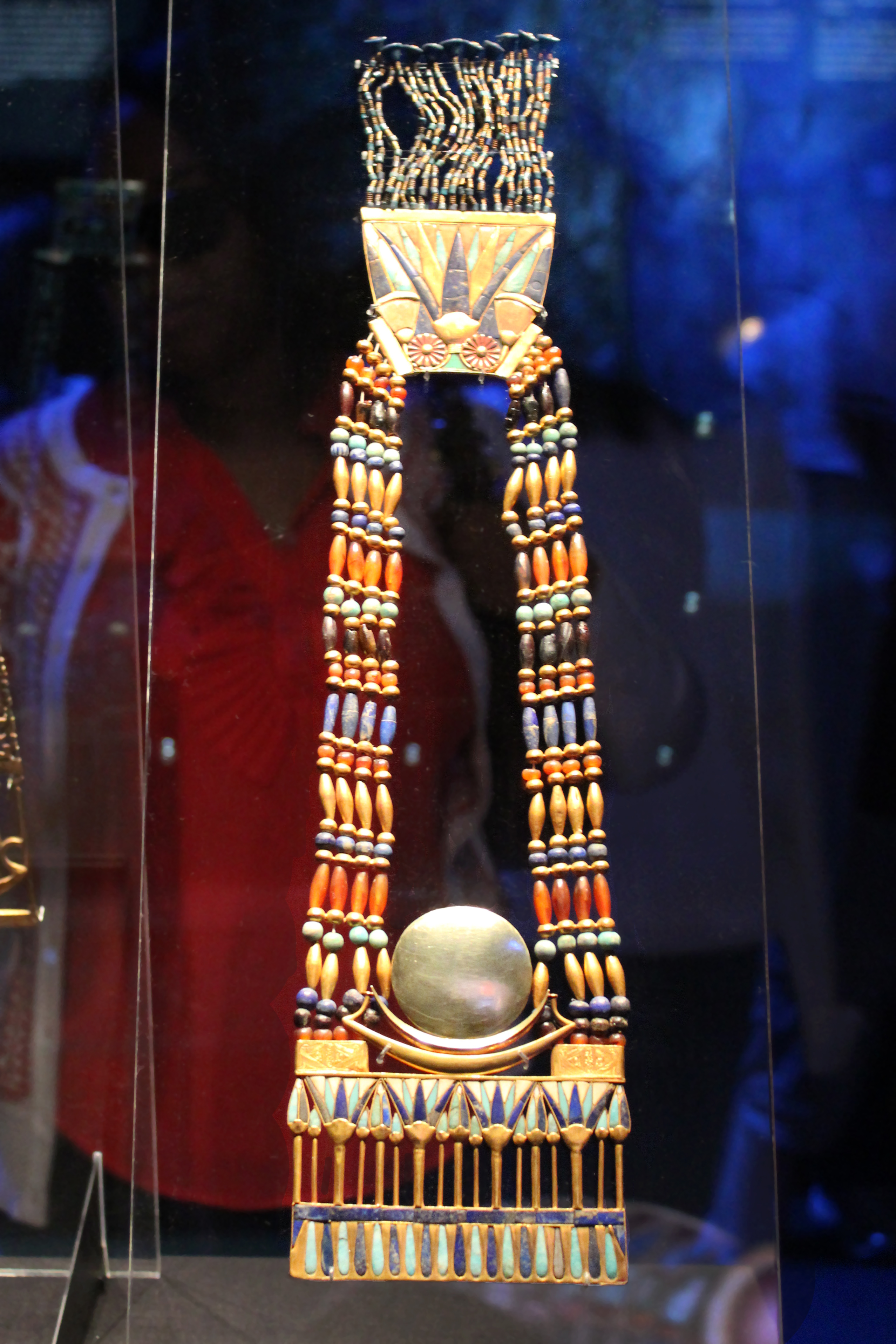
Pectoral of Tutankhamun in the Form of a Gold Boat and Silver Solar (more likely Lunar) Disk with Counterpoise and Chain
Gold, Electrum, Lapis Lazuli, Green Feldspar, Carnelian, Glass
Grand Egyptian Museum #139 (Formerly JE 61897)
Length of necklace (not including pectoral or counterpoise) 23.5cm (9.25 inches), width of pectoral 10.8cm (4.25 inches)
This was found in the cartouche-shaped box and likely worn during Tutankhamun's life.
|

One source different than the exhibit's info card says the disc is meant to depict the moon, as it is of silver hued electrum to convey the lunar aspect. (T.G.H. James, Tutankhamun, Metro books/White Star 2000) page 210) I'm inclined to agree with James, as the lunar god Djehuty (Thoth) often has a crown like this, the crescent moon under the full moon.
|

Gold Wesekh Collar and Counterpoise: Pectoral in the Shape of a Falcon
Sheet Gold, Gold Wire
Collar: Height 16.5cm (6.49 inches), Width 30.3cm (11.92 inches)
Counterpoise: Height 9.5cm (3.74 inches), Width 4cm (1.57 inches)
Grand Egyptian Museum #10835
The falcon represents the protective power of Horus (Heru)

Gold Wesekh Collar and Counterpoise: Vulture with Spread Wings and Uraeus
Grand Egyptian Museum # 10927
"A number of falcon jewels were found draped around Tutankhamun's neck, guarding the king from any evil that might attack him. Along with these were many vulture necklaces and amulets, representing the goddesses Nekhbet (tutelary goddess of Upper Egypt) and Mut (consort of Amun and mother goddess), as well as cobra-shaped jewels (representing Wadjet, tutelary goddess of Lower Egypt, and other goddesses), and other objects meant to ward off injury. Altogether there were about 150 objects wrapped with the king, set in place according to instruction laid out in the Book of the Dead." ( Zahi Hawass, Tutankhamun and the Golden Age of the Pharaohs (National Geographic 2005), page 278)
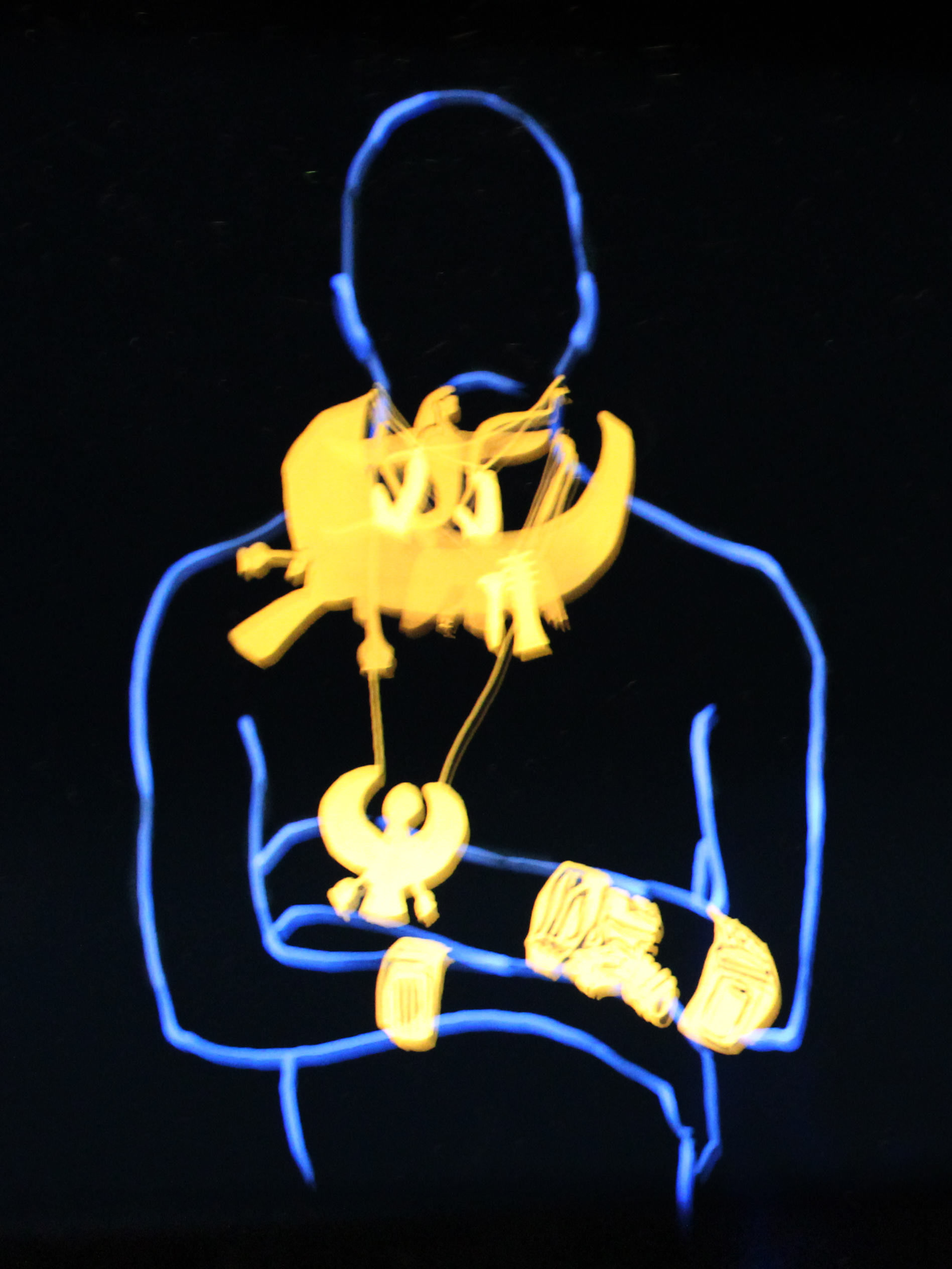
The illuminated info card illustrates some of these placements.
|
 Human-headed Uraeus with Wings
Human-headed Uraeus with Wings
Gold, Height 8.9 cm (3.50 inches), Width 13 cm (5.11 inches
Grand Egyptian Museum, #222 (Formerly JE 61855)
"Found at the neck of the king's mummy" (T.G.H. James, Tutankhamun, Metro books/White Star 2000) page 158)
|
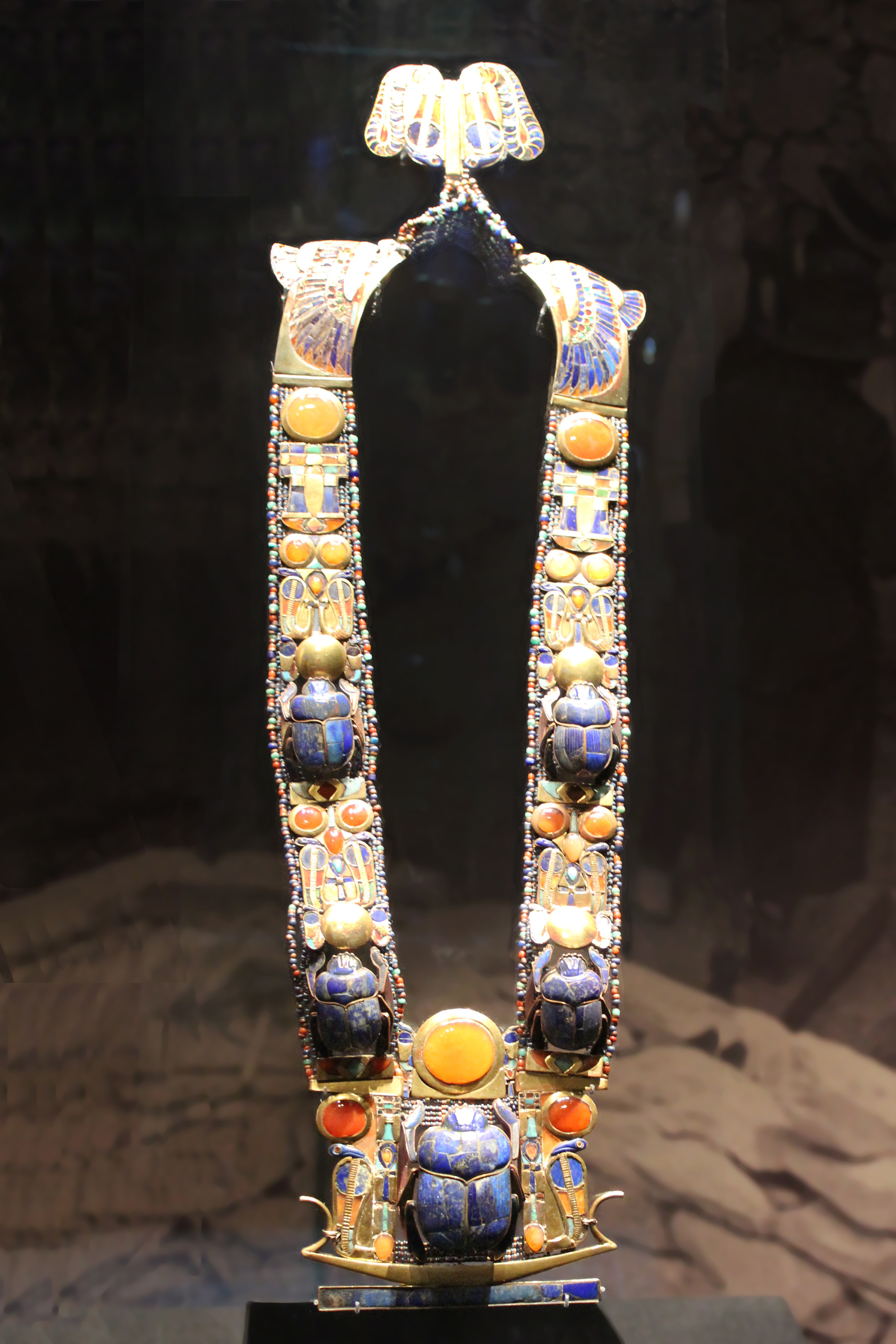
Necklace of the Sun Rising on the Horizon
Gold, Carnelian, Lapis Lazuli, Turquoise, Feldspar
Length of straps 50cm (19.6 inches), width of pectoral 11.8cm (4.64 inches)
Grand Egyptian Museum #??? (Formerly JE 61896)
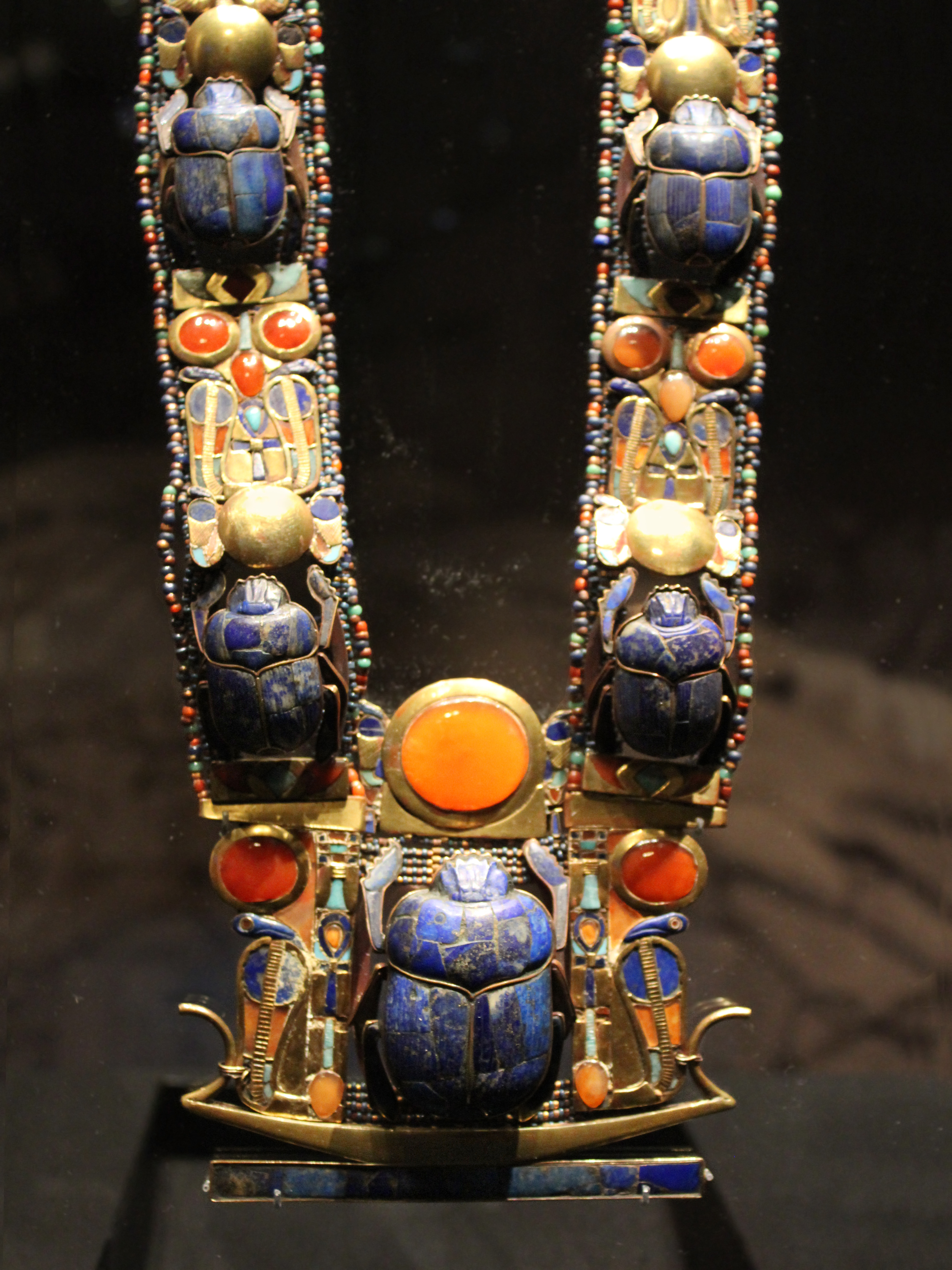
"This is one of the finest of the many pectorals found in the king's tomb. It has a large lapis lazuli scarab in the center, flanked by two uraei, or royal cobras.
"The scarab, standing on a solar boat, is pushing a carnelian disk which represents the rising sun and is flanked by symbols of stability, long life, and beauty.
"An elaborate chain consists of uraei and scarabs on Heb, or festival, signs." Source: Global Egyptian Museum
|
 "The straps terminate with curved gold elements carrying cloissonné vultures, the embodiment of Nekhbet, protective goddess of the king as ruler of Upper Egypt." (T.G.H. James, Tutankhamun, Metro books/White Star 2000) page 214)
"The straps terminate with curved gold elements carrying cloissonné vultures, the embodiment of Nekhbet, protective goddess of the king as ruler of Upper Egypt." (T.G.H. James, Tutankhamun, Metro books/White Star 2000) page 214)
|
 Bracelet with Three Scarabs
Bracelet with Three Scarabs
Lapis Lazuli, Gold, Green Feldspar, Carnelian, Glass
Length 17.6cm (6.92 inches), Height 4.3cm (1.69 inches)
Grand Egyptian Museum #157 (Formerly JE 62362)
Tutankhamun had a lot of bracelets, most of which were found within his mummy wrappings. However most were used during his life. These scarabs signify regeneration (coming into being). The clasp has an unusual motif, a grasshopper. This too, most likely has some magical/religious import. (Info summarized from T.G.H. James, Tutankhamun, Metro books/White Star 2000) page 245)
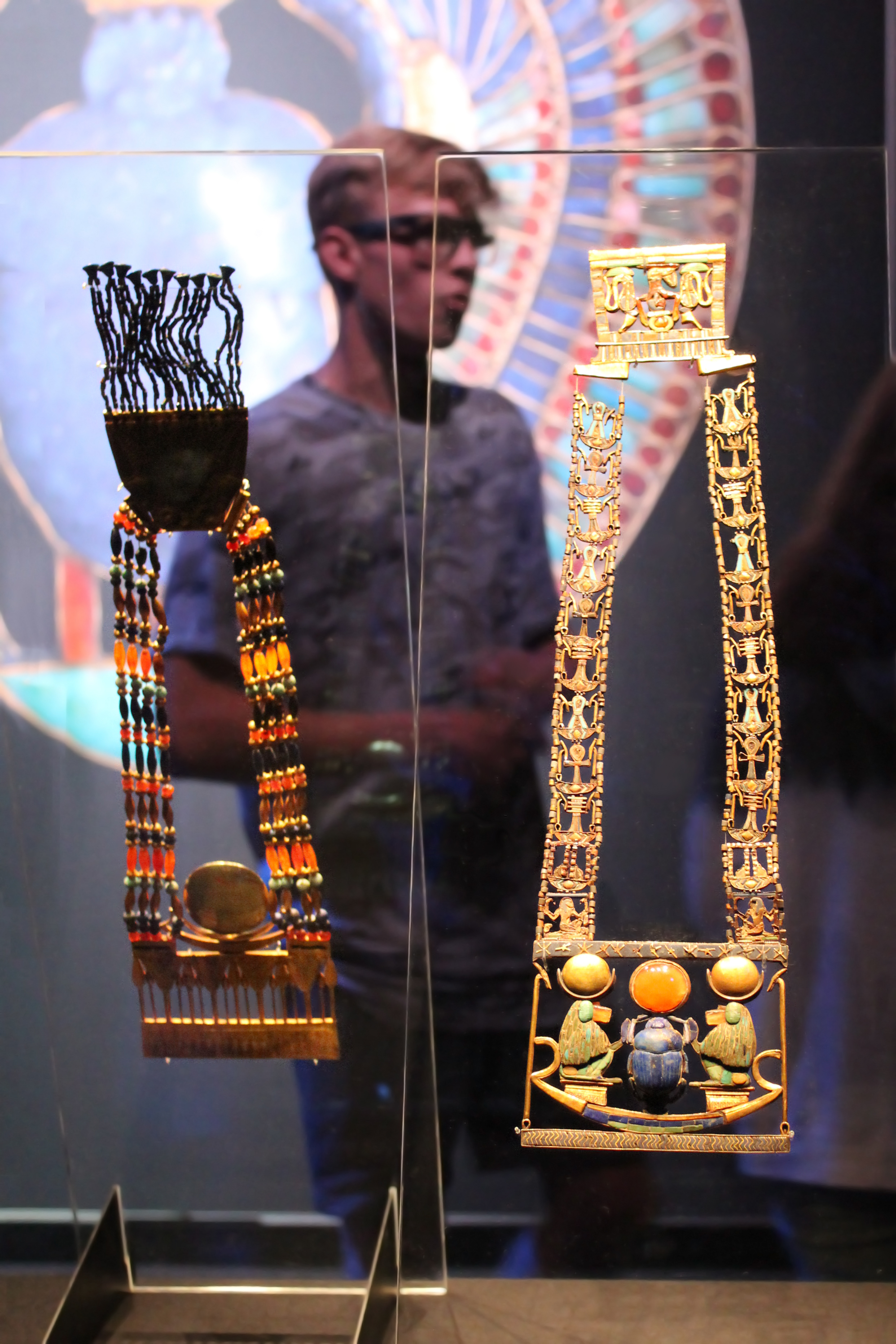
Left: The reverse of the pectoral in the Form of a Gold Boat and Silver Lunar Disk
 Necklace of the Rising Sun
Necklace of the Rising Sun
Gold, Silver, Lapis Lazuli, Turquoise, Faience, Calcite
Width of pectoral 11.5cm (4.52 inches)
The exhibition catalog identifies the two baboons as being the deity Thoth (Djehuty), but it's possible they do not represent a Name of Netjer (deity), but a Netjeri, divine spirits which are not actual gods. If so, they would still have a connection to Djehuty, possibly being created by him, as they are wearing the lunar crown he wears.
"The striking design of the pectoral shows the sun at its rebirth at dawn as the beetle Khepri, rising on the circular shen-sign of universal power in the morning bark. Khepri and the sun-disk are adored by two baboons, creatures which in nature greet the morning sun with howls, and in Egyptian mythology worship the rising sun with raised paws."
(T.G.H. James, Tutankhamun, Metro books/White Star 2000) page 216)
 Width of counterpoise 6.3cm (2.48 inches)
Width of counterpoise 6.3cm (2.48 inches)
The pectoral is bordered by two Was scepters:

Was scepters shown standing on the hieroglyph denoting earth (ta) and holding up the sky (pet hieroglyph), (from _Symbol and Magic in Egyptian Art_, by Richard H. Wilkinson, page 139)
The two-dimensional depiction is understood to represent three dimensions, thus two was scepters represent four.
In the pectoral the Was scepters are holding up the sky and resting on the waters.
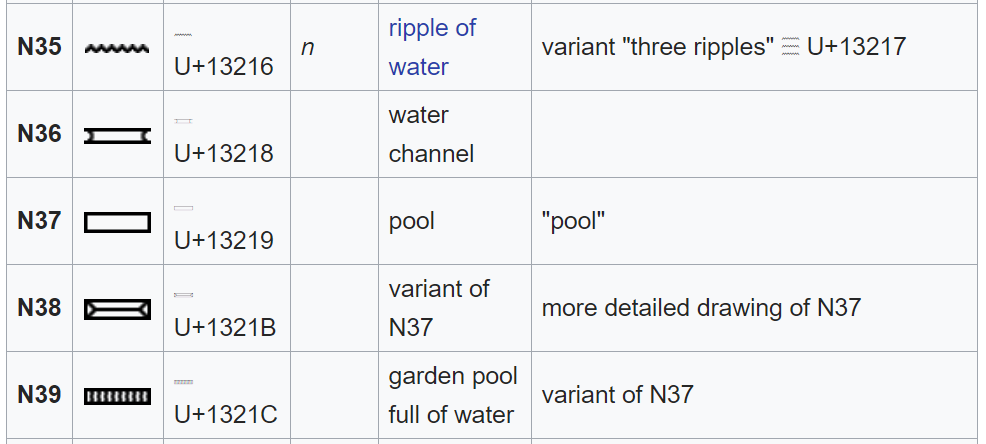
We can see the bottom rectangle is Gardiner N37, filled with the zig zag N35, to convey ripples of water. (Source: Wikipedia)
Tutankhamun had both small amuletic Was scepters and tall Was scepters to represent and amplify his power as pharaoh. One of them was included in the exhibit:
|
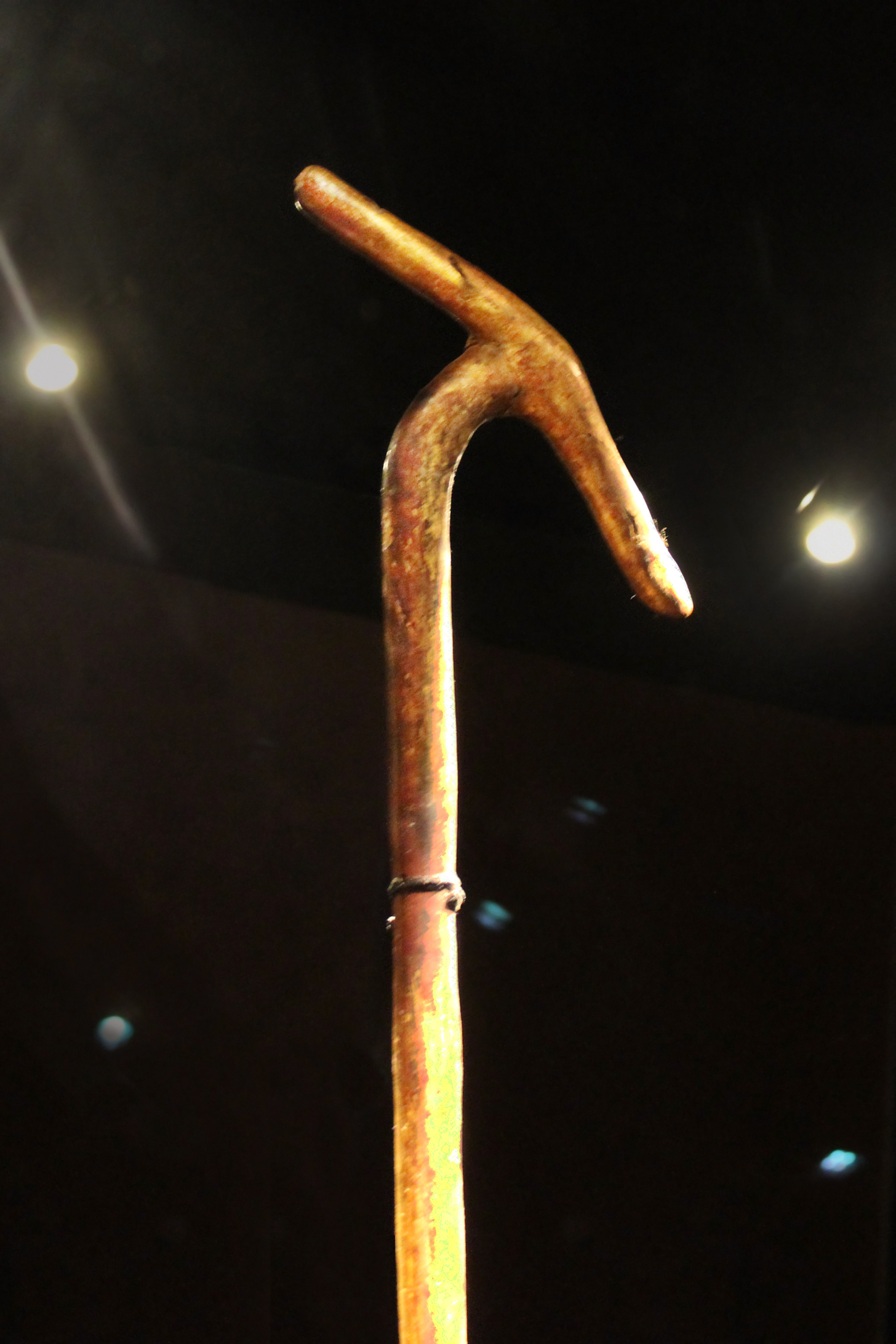
Gilded Wooden Was Scepter
Wood, Gesso, Gold Leaf
Grand Egyptian Museum #15841
|
|
In the following statue, the king holds the flail as a symbol of power and rulership.

The King on a Leopard
Wood, Gesso, Gold Leaf, Colored Glass (Eyes and Brows), Bronze (flail, scepter, uraeus and sandals)
Height 85.6cm (33.7 inches)
Grand Egyptian Museum #? (Formerly JE 60715)
|
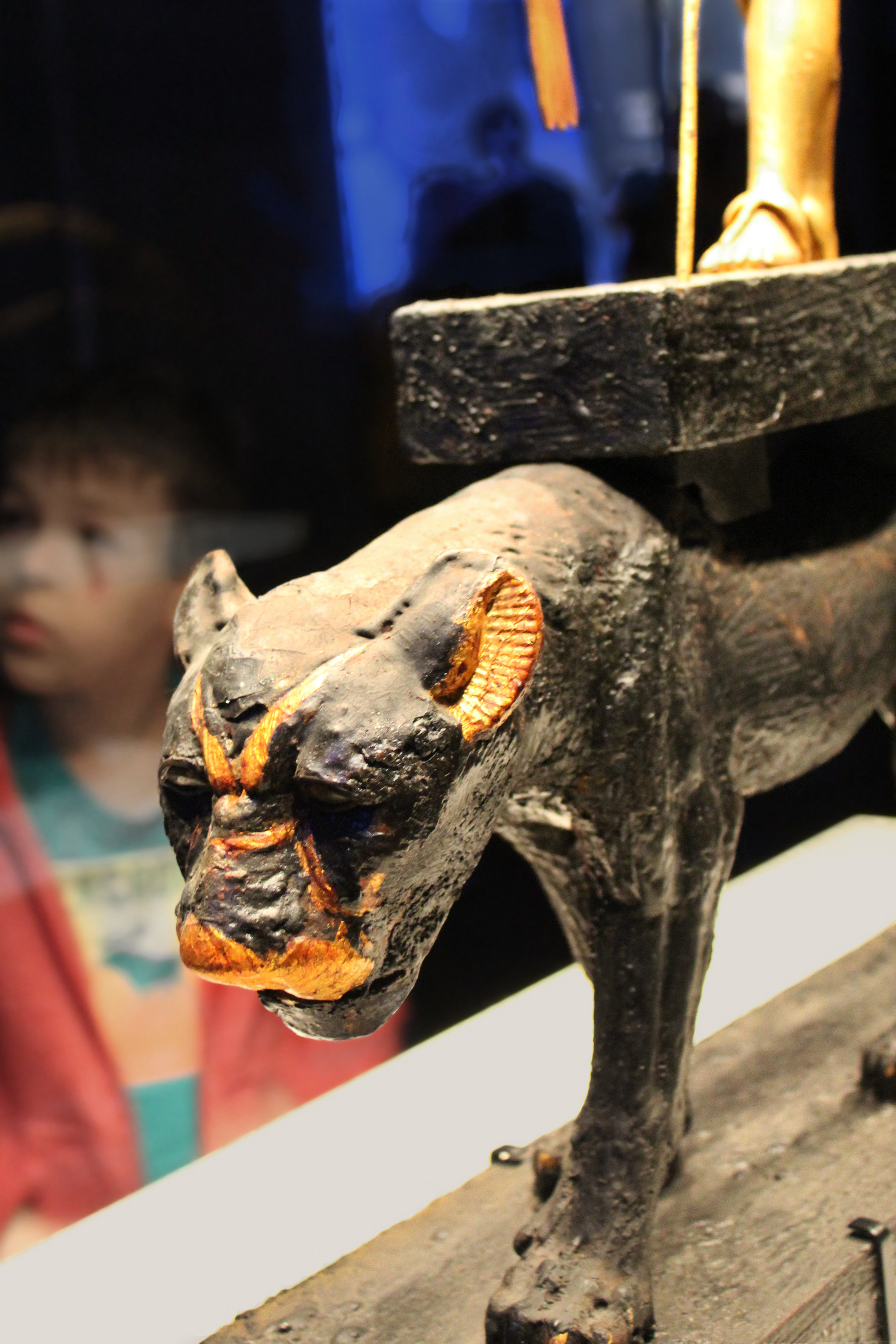
The leopard conveys an intense vital ferocity.
|
 Pectoral in the form of a Falcon with Sundisk, Outstretched Wings and Holding Ankh and Shen signs in its claws
Pectoral in the form of a Falcon with Sundisk, Outstretched Wings and Holding Ankh and Shen signs in its claws
Width 12.6cm (4.96 inches)
Grand Egyptian Museum #? (Formerly JE 61893)
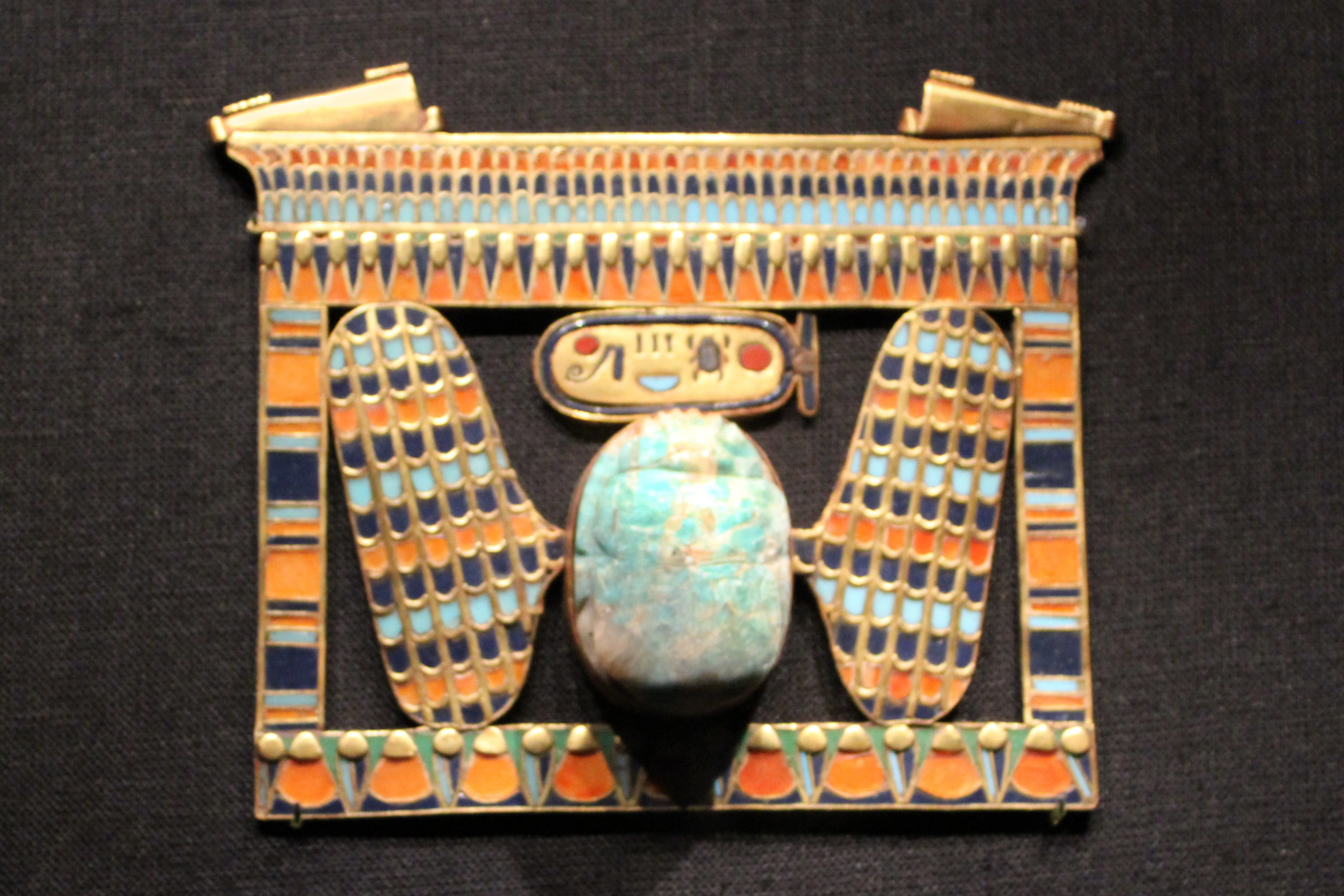
I neglected to photograph the info card, and neither of the two books I have, nor the Global Egyptian Museum website references it.
The scarab looks to be of green feldspar, and the cartouche bears Tutankhamun's name (NebKheperra).
The following is a statue that's long been a favorite of mine, inspiring me to some artwork:
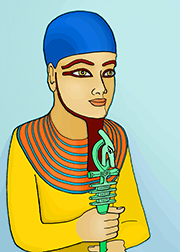
Ptah
So I was very thrilled to meet it in person. I spent a long time before its perfection! Compared to my photo, my artwork seems skewed, with the arm angle and curve of head not correct. That is because the reference photo I used is spread over two pages, with some data being lost in the process. I may need to revise my artwork!
|
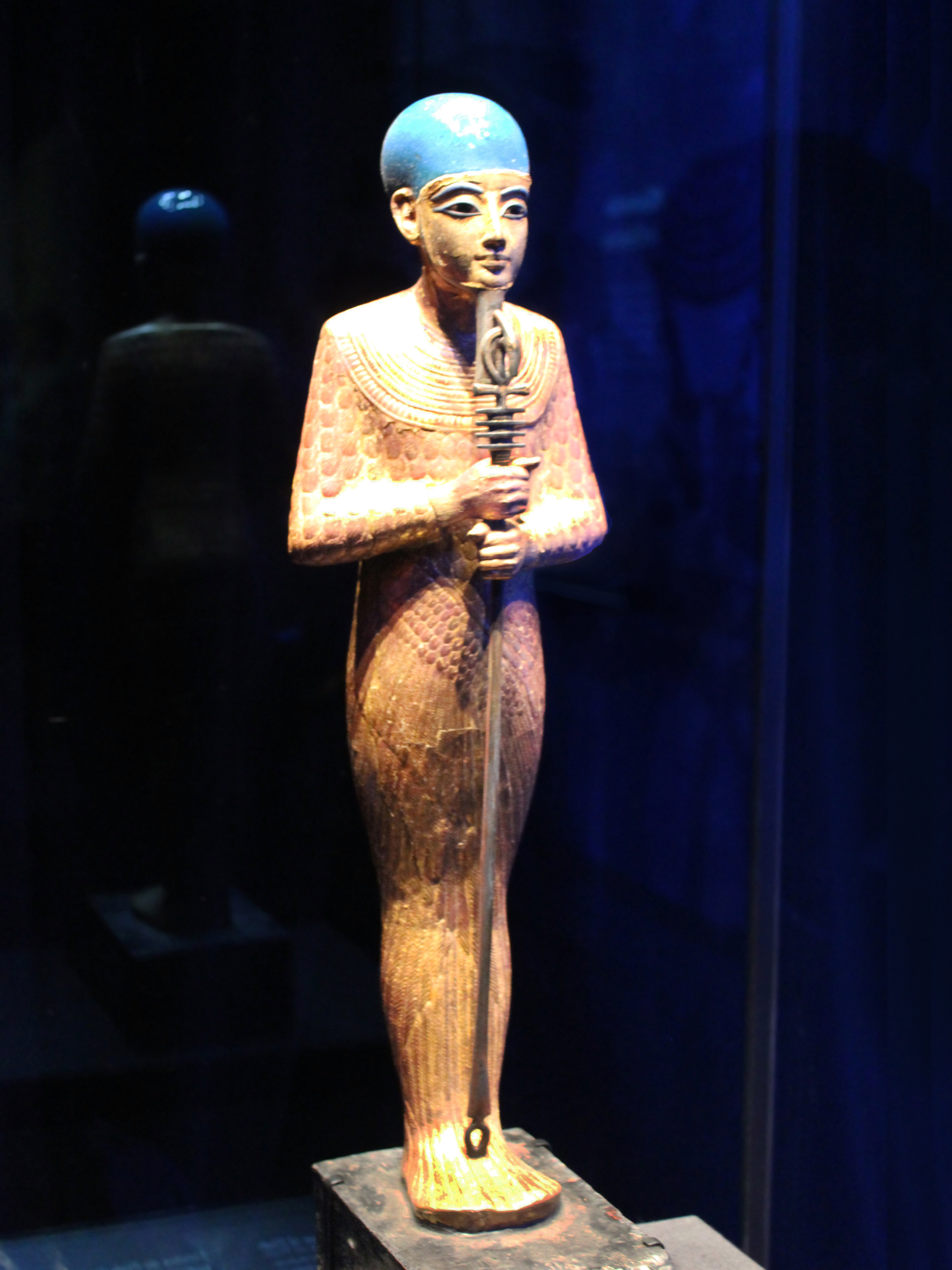
Gilded Wooden Statue of Ptah (Ptah wears a cobalt-blue glass skullcap.)
Wood, Gesso, Gold Leaf, Black Resin, Blue Faience, Glass (eyes)
Height 60.2cm (23.7 inches)
Reign of Tutankhamun 1336-1326 BCE
Grand Egyptian Museum #109 (formerly JE 60739)
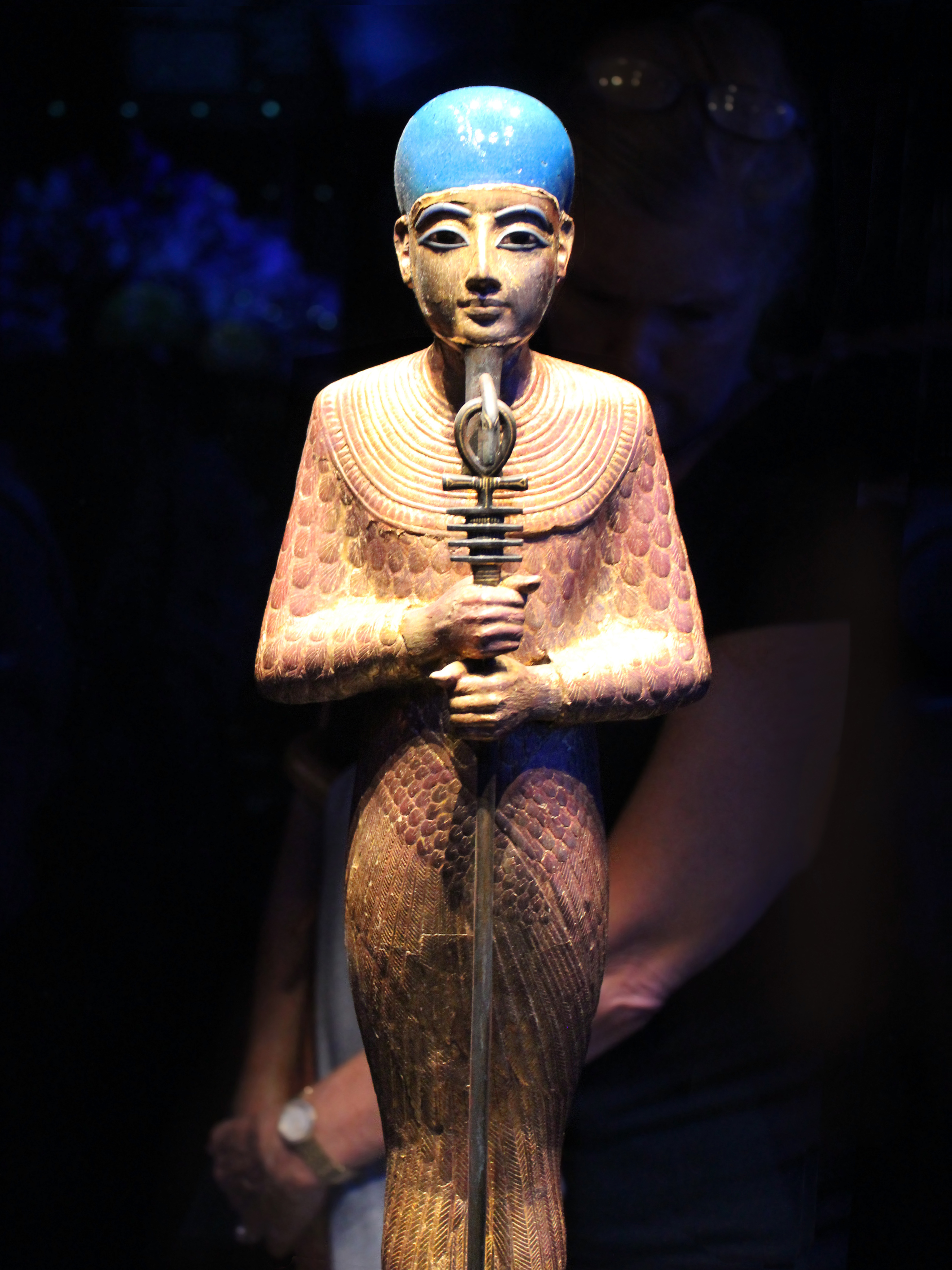
The gilding on the "body has a high copper content, making it appear red; the gold of the face is more yellow." (Zahi Hawass, Tutankhamun and the Golden Age of the Pharaohs (National Geographic 2005), page 204)



Fuzzy, but I include the photo anyway!
The statue of Ptah clearly looks like the Tutankhamun face and figure, maybe a little thick in the hips, but in general, fairly true. However the statue below doesn't, despite its being labelled for him.

Wooden Statue of the King in the White Crown
Wood, Gold Leaf, Gesso, Black Resin, Bronze
Height 75.3cm (29.64 inches)
Grand Egyptian Museum #11550 (formerly JE 62360)


"An inscription on the base in yellow paint identifies this statue as 'The Good God, Nebkheperure, justified', that is Tutankhamun. But there is no doubt that it does not look like him and the bodily details are in the Amarna style." (T.G.H. James, Tutankhamun, Metro books/White Star 2000) page 177) Possibly it and a matching one of the king in the Red Crown (along with the statue of the king on a leopard) were made for Nefertiti and/or Smenkhkare.
But changing the name magically changed the intent of this statue. (Granted, one looking more like Tutankhamun would be more effective, but in a pinch, a name change works!)

|
Spell 144,
Book of the Dead
"I know you and I know your names."
"The act of speaking aloud the name of the deceased restored him to life and, if repeated daily, guaranteed his immortality." The Ka of Tutankhamun Nebkheperra is immortal, indeed!
|


![]()